
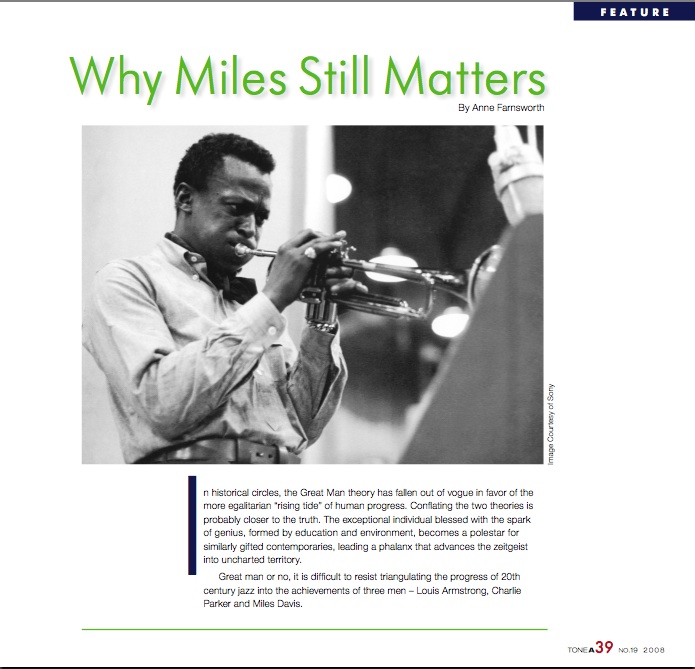
In historical circles, the Great Man theory has fallen out of vogue in favor of the more egalitarian ‘rising tide’ of human progress. Conflating the two theories is probably closer to the truth. The exceptional individual blessed with the spark of genius, formed by education and environment, becomes a polestar for similarly gifted contemporaries, leading a phalanx that advances the zeitgeist into uncharted territory.
Great man or no, it is difficult to resist triangulating the progress of 20th century jazz into the achievements of three men – Louis Armstrong, Charlie Parker and Miles Davis.
Miles Davis was a restless soul. Constantly searching, never satisfied, his quest for the New, the Next, reinvented the sound of Jazz via new approaches to harmony and improvisation and catapulting the young talent he mentored into their own creative orbits.
In 1945, the teenaged Davis left East St. Louis, IL, for New York City, ostensibly to study at Juilliard. But his real mission was to track down Parker and his colleague, Dizzy Gillespie, players he had met during a brief but life-altering stint in Billy Eckstine’s band. The older rising stars of Bebop, the new sound of jazz, took Davis under their wing; taking him to jam sessions, introducing him around and bestowing instant credential-by-association.
Charlie ‘Bird’ Parker’s drug and alcohol problems kept him constantly scuffling for cash and the weekly allowance sent to Davis by his wealthy father may have factored into Parker’s interest in mentoring the teenager. But Bird,
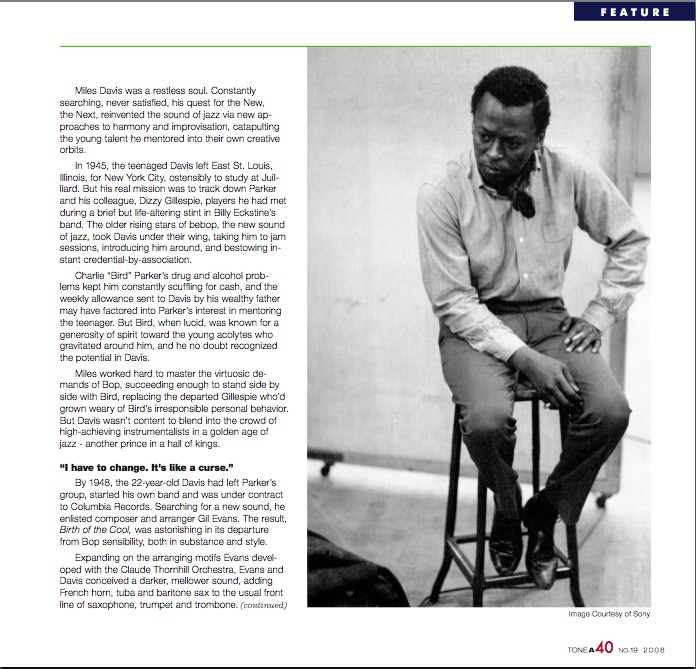
when lucid, was known for a generosity of spirit toward the young acolytes who gravitated around him and no doubt recognized the potential in Davis.
Miles worked hard to master the virtuosic demands of Bop, succeeding enough to stand side by side with Bird, replacing the departed Gillespie who’d grown weary of Bird’s irresponsible personal behavior. But Davis wasn’t content to blend into the crowd of high-achieving instrumentalists in a golden age of jazz - another prince in a hall of kings.
“I have to change. It’s like a curse.”
By 1948, 22-year-old Evans had left Parker’s group, started his own band and was under contract to Columbia Records. Searching for a new sound, he enlisted composer and arranger Gil Evans. The result, Birth Of The Cool, was astonishing in its departure from Bop sensibility, both in substance and style.
Expanding on the arranging motifs Evans developed with the Claude Thornhill Orchestra, Evans and Davis conceived a darker, mellower sound, adding French horn, tuba and baritone sax to the usual front line of saxophone, trumpet and trombone.
The texture was smooth, lower in register and volume and nearly vibrato-free. Thematically, the relaxed quality of the melodic lines played over slower tempi was a repudiation of the emotionalism and high drama of Bop.
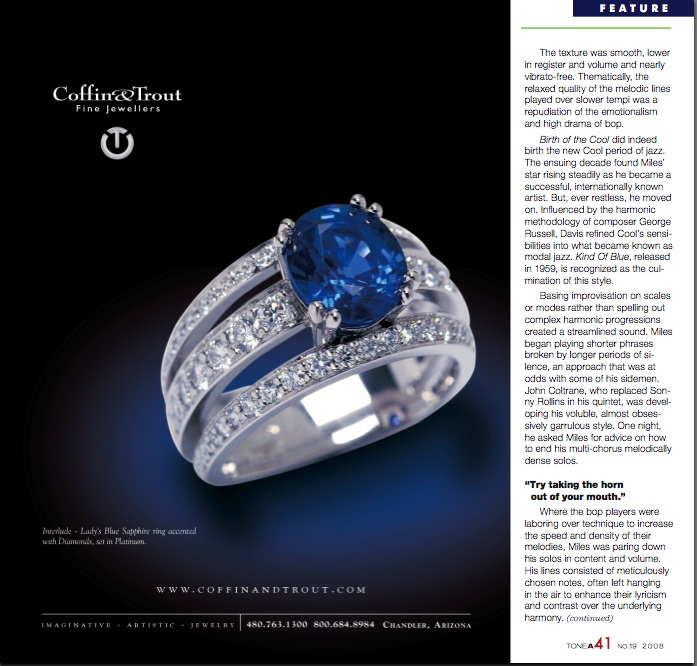
Birth Of The Cool did indeed birth the new Cool period of Jazz. The ensuing decade found Miles’ star rising steadily as he became a successful, internationally known artist. But ever restless, he moved on. Influenced by the harmonic methodology of composer George Russell, Davis refined Cool’s sensibilities into what became known as Modal Jazz. Kind Of Blue, released in 1959, is recognized as the culmination of this style.
Basing improvisation on scales or modes rather than spelling out complex harmonic progressions created a streamlined sound. Miles began playing shorter phrases broken by longer periods of silence, an approach that was at odds with some of his sidemen. John Coltrane, who replaced Sonny Rollins in his quintet, was developing his voluble, almost obsessively garrulous style. One night, he asked Miles for advice on how to end his multi-chorus melodically dense solos.
“Try taking the horn out of your mouth.”
Where the Bop players were laboring over technique to increase the speed and density of their melodies, Miles was paring down his solos in content and volume. His lines consisted of meticulously chosen notes, often left hanging in the air to enhance their lyricism and contrast over the underlying harmony. He was also using a Harmon mute almost exclusively, softening his sound to a whisper that matched his famously damaged speaking voice.
Miles brought this laconic style of playing into the next decade, when in the the late ‘60’s, he
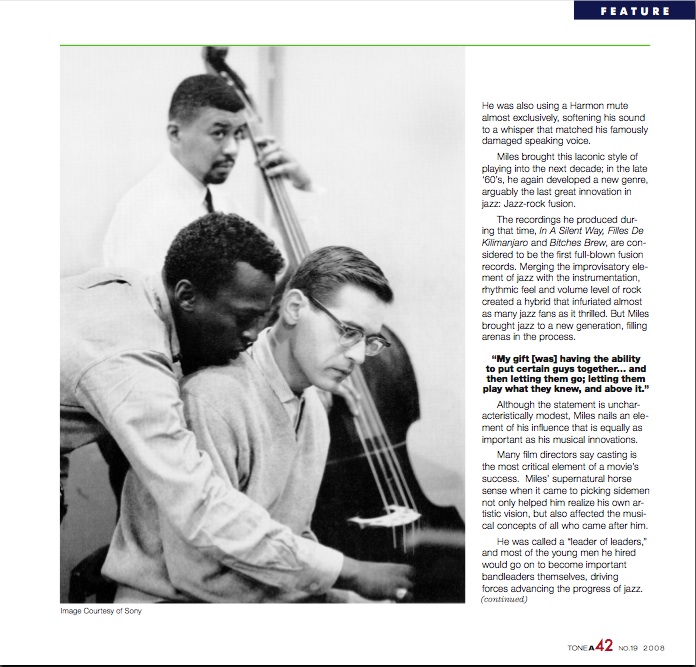
again developed a new genre, arguably the last great innovation in Jazz – Jazz-Rock Fusion.
The recordings he produced during that time, In A Silent Way, Filles De Kilimanjaro and Bitches Brew, are considered to be the first full-blown fusion records. Merging the improvisatory element of jazz with the instrumentation, rhythmic feel and volume level of rock created a hybrid that infuriated almost as many jazz fans as it thrilled. But Miles brought Jazz to a new generation, filling arenas in the process.
"My gift [was] having the ability to put certain guys together… and then letting them go; letting them play what they knew, and above it."
Although the statement is uncharacteristically modest, Miles nails an element of his influence that is equally as important as his musical innovations.
Many film directors say casting is the most critical element of a movie’s success. Miles’ supernatural horse sense when it came to picking sidemen not only helped him realize his own artistic vision, but also affected the musical concepts of all who came after him.
Called a “leader of leaders”, most of the young men he hired would go on to become important bandleaders themselves, driving forces advancing the progress of Jazz.
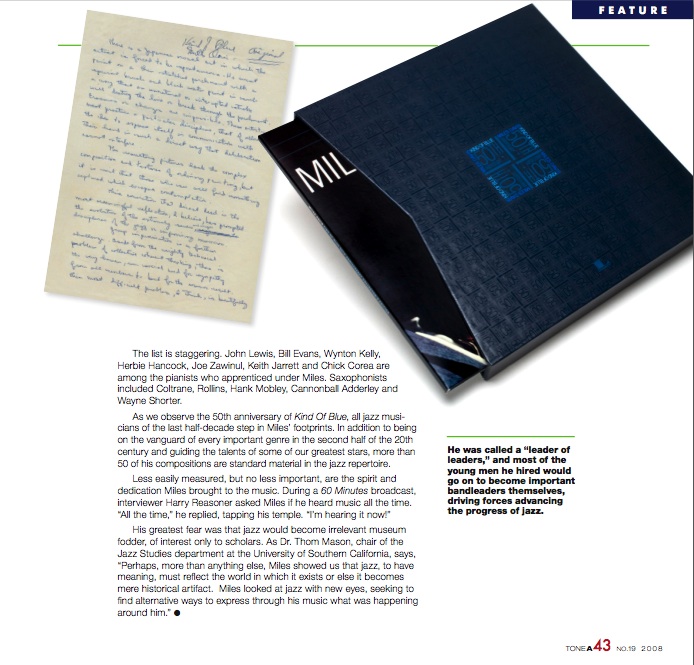
The list is staggering. John Lewis, Bill Evans, Wynton Kelly, Herbie Hancock, Joe Zawinul, Keith Jarrett and Chick Corea are among the pianists who apprenticed under Miles. Saxophonists included Coltrane, Rollins, Hank Mobley, Cannonball Adderley and Wayne Shorter.
As we observe the 50th anniversary of Kind Of Blue, all jazz musicians living today step in Miles’ footprints. In addition to being on the vanguard of every important genre in the second half of the 20th century and guiding the talents of some of our greatest stars, over 50 of his compositions are standard material in the Jazz repertoire.
Less easily measured, but no less important, are the spirit and dedication Miles brought to the music. During a CBS “60 Minutes” broadcast, interviewer Harry Reasoner asked Miles if he heard music all the time. “All the time”, he replied, tapping his temple. “I’m hearing it now!”
His greatest fear was that Jazz would become irrelevant museum fodder, of interest only to scholars. As Dr. Thom Mason, chair of the Jazz Studies Dept. at USC, says, “Perhaps, more than anything else, Miles showed us that jazz, to have meaning, must reflect the world in which it exists or else it becomes mere historical artifact. Miles looked at jazz with new eyes, seeking to find alternative ways to express through his music what was happening around him.”
Copyright 2008 All rights reserved
Anne Farnsworth & Tone Publications